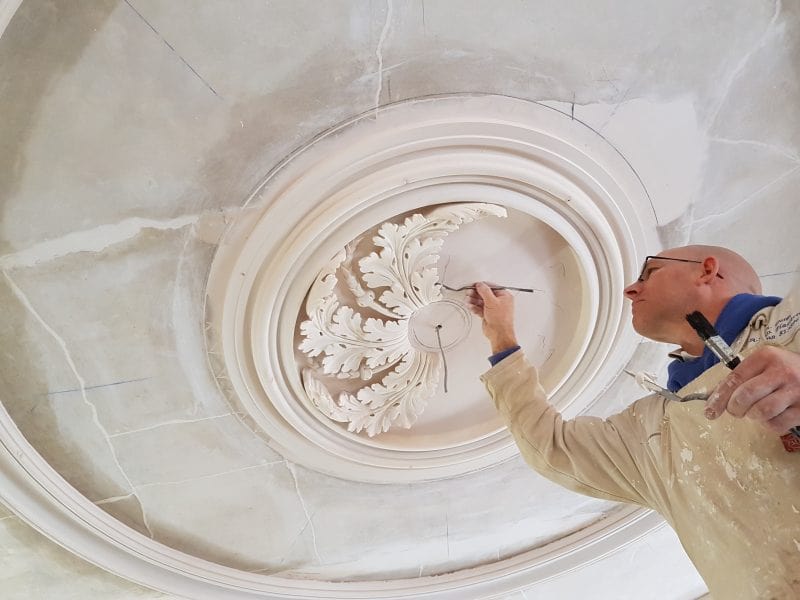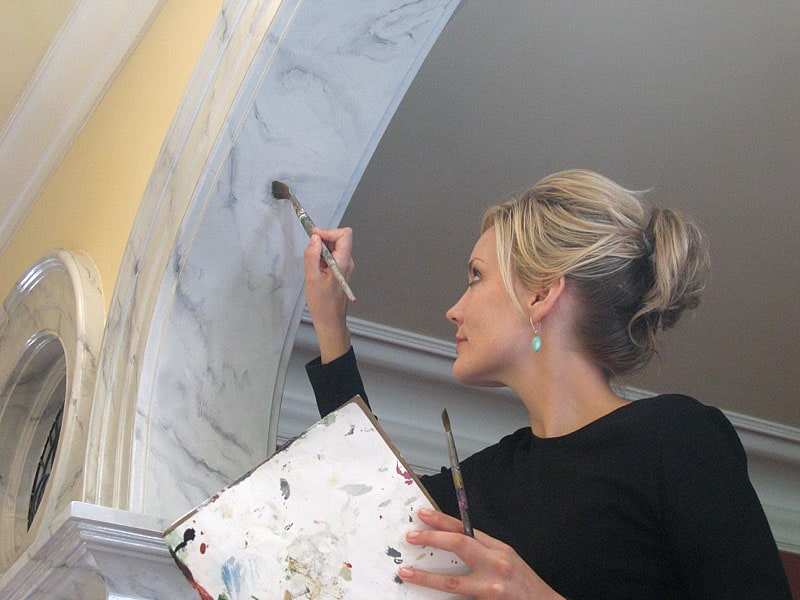
It has long gone down in history those times when at the peak of popularity were wallpaper, and those wallpaper, which could be obtained, and decorated the room for the next decades. Today, the market of building materials is full of different types of finishing for walls, among them there is also decorative plaster.
ADVANTAGES OF DECORATIVE PLASTER
Decorative plaster example the first and most important advantage is its uniqueness. After all, even if the coating in two identical rooms will be applied by the same person with the same tool, it will still result in a different pattern, so this type of finish – a great chance to make your room unique. Besides, with the help of decorative plaster it is possible to achieve imitation of the coating for marble, metal, granite, silk, etc.
It is suitable for any type of interior, although many people believe that it best fits into the classic interior. With a competent selection of colors and textures, it will be an excellent addition to the interior in high-tech, modern, minimalist style.
It is not difficult to apply decorative plaster – it is rather a pleasant creative process, but you will have to try to prepare the surface, because the cleaner and smoother it will be, the better the result will be.
Decorative plaster in the interior this plaster can hide some of the disadvantages of walls, small cracks and irregularities, especially if its composition includes cellulose fibers. In addition, it is able to add heat to the room, as well selected plaster together with a good primer – not bad heat insulators.
Ecology and safety – another advantage. Thus, decorative plaster is made of natural materials, and the finished coating does not absorb odors, does not emit harmful substances, so it is not able to cause any inconvenience or harm to health.
The coating is also easy to use: it is durable, resistant to temperature fluctuations and virtually maintenance-free. All the more so because there are no seams, joints or other defects left on the surface.
Of course, it is impossible to pay attention to such a direct disadvantage as the high cost of the material. But if we consider that such a coating will last long enough, will be unique, easy to maintain and repair, and the cost of it is justified.
DECORATIVE PLASTER CLASSIFICATION
The whole variety of different types of surface obtained with the help of decorative plaster is formed by the fact that the compositions can be different: some have elements, thanks to which you can get a certain relief, and for others there must be a special approach and the ability to create the desired surface.
What does decorative plaster consist of? In most cases, the composition includes a water base, binders, additives and fillers such as thickeners, antiseptics, etc.
Fillers can be completely different, but in addition to the filler, plasters can also differ in their basic composition. And it is this characteristic that makes this or that material applicable in specific conditions.

Interior decorative plasters distinguished by such basic types:
- Mineral plaster is produced on the basis of cement and sold dry, so immediately before using it must be mixed with water and turned into a homogeneous mass with the help of a construction mixer at low revolutions. This type of finish is perfect for mineral bases, but the use of quartz primer is necessary, it has good indicators of strength, durability and water vapor permeability. But, as you can guess, mineral plaster is not subject to staining in mass, so be prepared for the fact that after application it will have to be stained additionally. Another advantage of this type of plaster is its low price, although there are also more expensive options, which include glitter, marble chips and other elements that are designed to improve the aesthetics of the finished coating.
- Decorative plaster in the interiorAcrylic plaster is a synthetic material that includes acrylic resin. It gives the material properties such as plasticity, ability to repel water, excellent adhesion to the mineral base. But the material is able to burn, so, for example, next to a mineral wool insulation it is better not to use it. But it is not difficult to work with it: it is easy to apply, it is easy to form a texture either with the help of a filler or with the help of a roller and a spatula. However, such furnish demands qualitative preparation of the basis and a first coat of primer about what we will talk further. Acrylic plaster is sold in its finished form, i.e. it is not necessary to dilute the dry mixture, but pay attention to the shelf life: if the date is close to the final date of operation, it is better not to take even at a reduced price such a material, as it will be difficult to work with it.
- Silicone plaster is considered the most modern and versatile: high elasticity, durability, adhesion to any type of substrate, water vapor permeability and aesthetic effect support the use of this type of finishing. This plaster is very easy to maintain and even self-clean, so it is often used to decorate facades. Sold ready-made, and with a certain color, and the color range is quite rich, which allows you to choose the most appropriate option, eliminates the need for further coloring, creates excellent color transitions, and work with such a material can even be a beginner in the construction industry. As you could already guess that all this durability and high aesthetics costs a lot of money, and the primer will need a special – silicone, but the result will please you, and will be very happy for a long time.
- But silicate plaster, which is made on the basis of potassium glass, is rarely used for interior decoration of walls, which is what we are talking about. Most often, silicate plaster is used for facade works, as in operation it can emit harmful substances. In addition, it is not very easy to apply: it is quickly caught, so you need some skill to have time to distribute it and create a pattern.
In addition, all decorative plasters differ in the type of finished surface: bark beetle, with marble chips, with the imitation of granite, rain, under the roller, under the rust, Venetian, etc. Textures can also be made using grinders, spatulas, fabrics and other materials to move away from the typical factory solutions with filler, but the relief technique is used a little later.
Decorative plasters according to the type of filler:
- textured plaster is the most popular and relatively inexpensive type of plaster, where wood fibers, small stones, mica, etc. are used as fillers. Thanks to this inclusion the surface becomes truly three-dimensional, which is not under the power of any wallpaper or painting. To enhance the effect, all kinds of rollers and stamps are often additionally used; textured decorative plaster
- Structural plaster uses fine grains of quartz and other minerals as fillers, and as a result the finished surface turns out to be homogeneous in contrast to the previous type. Often it is with this type of plaster that the known “bark beetle” surface is prepared, which resembles the bark surface of a tree. If the size of the filler will be a little more than the standard, you can get on the walls of a good mosaic effect; structural decorative plaster
- Venetian plaster is made on the basis of marble crumb, it is very homogeneous and as a result a smooth shiny marble covering is obtained; Venetian decorative plaster
- The flock coating is a more modern design, the result of which is an interesting appearance. The coating is applied in several layers: adhesive base, flocks themselves, i.e. colored insoluble particles, and lacquer coating.





